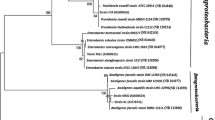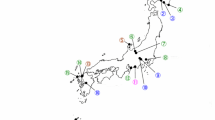Abstract
Twenty-five bacterial strains isolated from entomopathogenic nematodes were characterized to the genus level by 16S rRNA phylogeny and BLAST analyses. Bacteria strains isolated could be affiliated with seven genera. Microbacterium-like isolates phylogenetically affiliated with M. oxydans while those of Serratia were highly similar to S. marcescens. 16S rRNA sequences of Bacillus isolates matched those of both B. mycoides and B. weihenstephanesis. One isolate each matched Pseudomonas mosselii, Rheinheimera aquimaris, Achromobacter marplatensis, or Staphylococcus hominis. Serratia isolates were examined further for their pathogenicity to Galleria mellonella larvae. All the Serratia isolates exhibited potent pathogenicity toward G. mellonella larvae and possessed a metalloprotease gene encoding for a novel serralysin-like protein. The nucleotide sequence of the metalloprotease gene had 60 synonymous and 8 nonsynonymous substitutions when compared to the closest genBank entry, S. marcescens E-15, with an insertion of a new aspartic acid residue. Tajima’s test for equality of evolutionary rate was significant between the metalloprotease gene sequence of S. marcescens strain DOAB 216-82 (this study) and strain E-15. This new insecticidal metalloprotease gene and/or its product could have applications in agricultural biotechnology.


Similar content being viewed by others
References
Babic I, Fischer-Le Saux M, Giraud E, Boemare N (2000) Occurrence of natural dixenic associations between the symbiont Photorhabdus luminescens and bacteria related to Ochrobactrum spp. in tropical entomopathogenic Heterorhabditis spp. (Nematoda, Rhabditida). Microbiology 146(Pt 3):709–718
Chaston JM, Suen G, Tucker SL, Andersen AW, Bhasin A, Bode E, Bode HB et al (2011) The entomopathogenic bacterial endosymbionts Xenorhabdus and Photorhabdus: convergent lifestyles from divergent genomes. PLoS One 6:e27909
Forst S, Clarke D (2002) Bacteria-nematode symbioses. CABI, Wallingford
Derzelle S, Turlin E, Duchaud E, Pages S, Kunst F, Givaudan A, Danchin A (2004) The PhoP-PhoQ two-component regulatory system of Photorhabdus luminescens is essential for virulence in insects. J Bacteriol 186:1270–1279
Zhang CX, Yang SY, Xu MX, Sun J, Liu H, Liu JR, KanF Lai R, Zhang KY (2009) Serratia nematodiphila sp. nov., associated symbiotically with the entomopathogenic nematode Heterorhabditidoides chongmingensis (Rhabditida: Rhabditidae). Int J Syst Evol Microbiol 59:1603–1608
Grimont F, Grimont PAD (2005) Genus XXXIV. Serratia Bizio 1823, 288AL, 2nd edn. Springer, New York
Feng SL, Cao WP, Fan LH, Wang RY, Tsuguo M (2002) Identification of a Serratia marcescens stain and bioassay against Oedaleus infernalis Saussure. Chin J Biol Control 18:158–161
Stevenson JP (1959) Epizootology of a disease of the desert locust, Schistocerca gregaria (Forska¨l), caused by nonchromogenic strains of Serratia marcescens Bizio. J Insect Pathol 1:232–244
Tao K, Long Z, Liu K, Tao Y, Liu S (2006) Purification and properties of a novel insecticidal protein from the locust pathogen Serratia marcescens HR-3. Curr Microbiol 52:45–49
Tao K, Yu X, Liu Y, Shi G, Liu S, Hou T (2007) Cloning, Expression, and Purification of Insecticidal Protein Pr596 from Locust Pathogen Serratia marcescens HR-3. Curr Microbiol 55:228–233
Flyg C, Xanthopoulos KG (1983) Insect pathogenic properties of Serratia marcescens. Passive and active resistance to insect immunity studied with protease-deficient and phage-resistant mutants. J Gen Microbiol 129:453–464
Wang Q, Garrity GM, Tiedje JM, Cole JR (2007) Naive Bayesian classifier for rapid assignment of rRNA sequences into the new bacterial taxonomy. Appl Environ Microbiol 73:5261–5267
Gouge DH, Snyder JL (2006) Temporal association of entomopathogenic nematodes (Rhabditida: Steinernematidae and Heterorhabditidae) and bacteria. J Invertebr Pathol 91:147–157
Zhang C, Liu J, Xu M, Sun J, Yan S, An X, Gao G, Lin M, Lai R, He Z, Wu Y, Zhang K (2008) Heterorhabditidoides chongmingensis gen. nov., sp. nov. (Rhabditida: Rhabditidae), a novel member of the entomopathogenic nematodes. J Invertebr Pathol 98:153–168
Wernersson R, Pedersen AG (2003) RevTrans: Multiple alignment of coding DNA from aligned amino acid sequences. Nucleic Acids Res 31:3537–3539
Korber B (2000) HIV signature and sequence variation analysis. In: Rodrigo AG, Learn GH (eds) Computational analysis of HIV molecular sequences. Kluwer Academic Publishers, Dordrecht, pp 55–72
Tajima F (1993) Simple methods for testing the molecular evolutionary clock hypothesis. Genetics 135:599–607
Lane DJ (1991) 16S/23S sequencing. In: Stackebrandt E, Goodfellow M (eds) Nucleic acid technologies in bacterial systematics. Wiley, Chichester, pp 115–175
Tambong JT, Mwange KN, Bergeron M, Ding T, Mandy F, Reid LM, Zhu X (2008) Rapid detection and identification of the bacterium Pantoea stewartii in maize by TaqMan real-time PCR assay targeting the cpsD gene. J Appl Microbiol 104:1525–1537
Guindon S, Dufayard JF, Lefort V, Anisimova M, Hordijk W, Gascuel O (2010) New algorithms and methods to estimate maximum-likelihood phylogenies: assessing the performance of PhyML 3.0. Syst Biol 59:307–321
Dauga C (2002) Evolution of the gyrB gene and the molecular phylogeny of Enterobacteriaceae: a model molecule for molecular systematic studies. Int J Syst Evol Microbiol 52:531–547
Tamura K, Peterson D, Peterson N, Stecher G, Nei M, Kumar S (2011) MEGA5: molecular evolutionary genetics analysis using maximum likelihood, evolutionary distance, and maximum parsimony methods. Mol Biol Evol 28:2731–2739
Kaya HK, Gaugler R (1993) Entomopathogenic nematodes. Annu Rev Entomol 38:181–206
Poinar GO Jr, Wassink HJ, Leegwater-van der Linden ME, van der Geest LP (1979) Serratia marcescens as a pathogen of tsetse flies. Acta Trop 36:223–227
Boemare NE, Akhurst RJ, Mourant RG (1993) DNA relatedness between Xenorhabdus spp. (Enterobacteriaceae), symbiotic bacteria of entomopathogenic nematodes, and a proposal to transfer Xenorhabdus luminescens to a new genus, Photorhabdus gen. nov. Int J Syst Bacteriol 43:249–255
Mahar AN, Darban DA, Gowen SR, Hague NGM, Jan ND, Maha AQ (2005) Use of entomopathogenic bacterium Pseudomonas putida (Enterobacteriaceae) and its secretion against greater wax moth, Galleria mellonella, pupae. J Entomol 2:77–85
Poinar GO Jr, Thomas GM (1966) Significance of Achromobacter nematophilus Poinar and Thomas (Achromobacteraceae: Eubacteriales) in the development of the nematode, DD-136 (Neoaplectana sp., Steinernematidae). Parasitology 56:385–390
Rae R, Riebesell M, Dinkelacker I, Wang Q, Herrmann M, Weller AM, Dieterich C, Sommer RJ (2008) Isolation of naturally associated bacteria of necromenic Pristionchus nematodes and fitness consequences. J Exp Biol 211:1927–1936
Hase CC, Finkelstein RA (1993) Bacterial extracellular zinc-containing metalloproteases. Microbiol Rev 57:823–837
Ourth DD, Smalley L (1980) Phagocytic and humoral immunity of the adult cotton boll weevil, Anthonomus grandis (Coleoptera: Curculionidae), to Serratia marcescens. J Invertebr Pathol 36:104–112
Braunagel SC, Benedik MJ (1990) The metalloprotease gene of Serratia marcescens strain SM6. Mol Gen Genet 222:446–451
Nakahama K, Yoshimura K, Marumoto R, Kikuchi M, Lee IS, Hase T, Matsubara H (1986) Cloning and sequencing of Serratia protease gene. Nucleic Acids Res 14:5843–5855
McNichol BA, Rasmussen SB, Meysick KC, O’Brien AD (2006) A single amino acid substitution in the enzymatic domain of cytotoxic necrotizing factor type 1 of Escherichia coli alters the tissue culture phenotype to that of the dermonecrotic toxin of Bordetella spp. Mol Microbiol 60:939–950
Brown RM, Head RA, Boubriak II, Leonard JV, Brown GK (2003) A pathogenic glutamate-to-aspartate substitution (D296E) in the pyruvate dehydrogenase E1 subunit gene PDHA1. Hum Mutat 22:496–497
Acknowledgments
This research was funded by Agriculture and Agri-Food Canada through project #1800. We are grateful to Mr. R. Xu for assistance with some of the experiments; and to Mr. Rafik Assagbui for providing technical assistance with DNA sequencing. Thanks to Dr. Q. Yu and staff of the Nematology Unit and Entomology Biocontrol Laboratory for their assistance. Thanks to S. Miller for reviewing the manuscript.
Author information
Authors and Affiliations
Corresponding author
Electronic supplementary material
Below is the link to the electronic supplementary material.
Rights and permissions
About this article
Cite this article
Tambong, J.T. Phylogeny of Bacteria Isolated from Rhabditis sp. (Nematoda) and Identification of Novel Entomopathogenic Serratia marcescens Strains. Curr Microbiol 66, 138–144 (2013). https://doi.org/10.1007/s00284-012-0250-0
Received:
Accepted:
Published:
Issue Date:
DOI: https://doi.org/10.1007/s00284-012-0250-0




